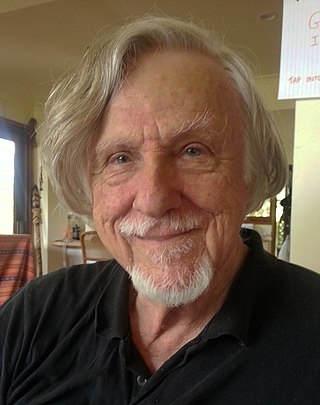
William Norman McLaren, LL. D. was a Scottish Canadian animator, director and producer known for his work for the National Film Board of Canada (NFB). He was a pioneer in a number of areas of animation and filmmaking, including hand-drawn animation, drawn-on-film animation, visual music, abstract film, pixilation and graphical sound. McLaren was also an artist and printmaker, and explored his interest in dance in his films.
Roman Kroitor was a Canadian filmmaker who was known as a pioneer of Cinéma vérité, as the co-founder of IMAX, and as the creator of the Sandde hand-drawn stereoscopic 3D animation system. He was also the original inspiration for The Force. His prodigious output garnered numerous awards, including two BAFTA Awards, three Cannes Film Festival awards, and two Oscar nominations.

Michael Dattilo Rubbo is an Australian documentarian/filmmaker.
Colin Archibald Low was a Canadian animation and documentary filmmaker with the National Film Board of Canada (NFB). He was known as a pioneer, one of Canada's most important filmmakers, and was regularly referred to as "the gentleman genius". His numerous honors include five BAFTA awards, eight Cannes Film Festival awards, and six Academy Award nominations.
Hugh O'Connor was a Canadian director and producer who worked for the National Film Board of Canada (NFB). His best- known film is the ground-breaking In the Labyrinth (1967), but his promising career ended shortly after that film's release when he was murdered while filming in Kentucky.
Bernard Devlin (1923–1983) was a Canadian film director, producer and writer who played an important role in the development of French-language film production at the National Film Board of Canada (NFB).

Thomas Cullen Daly was a Canadian film producer, film editor and film director, who was the head of Studio B at the National Film Board of Canada (NFB).
On the Spot was the first television series made specifically for TV by the National Film Board of Canada, and aired on CBC Television from 1953 to 1955. Each episode reported on a different aspect of life in Canada and was introduced with the line "The National Film Board’s up-to-the-minute report of what’s happening somewhere in Canada”. The series was originated by Bernard Devlin, with Robert Anderson as executive producer.
Jane Marsh Beveridge was a Canadian director, producer, editor, composer, screenwriter, teacher and sculptor. She was best known as one of the pioneering filmmakers at the National Film Board of Canada (NFB).
John Spotton C.S.C. was a Canadian filmmaker with the National Film Board of Canada.
Royal River is a 1959 Canadian documentary film directed by Gordon Sparling and Roger Blais for the National Film Board of Canada.
The 29th Canadian Film Awards were held on September 21, 1978 to honour achievements in Canadian film. They were the last Canadian Film Awards ceremony to be held before the program was taken over by the Academy of Canadian Cinema and Television, and restructured into the new Genie Awards.
David Bairstow (1921-1985) was a Canadian producer and director and one of the most prolific filmmakers at the National Film Board of Canada.
The 24th Canadian Film Awards were held on October 3, 1972 to honour achievements in Canadian film.
The 23rd Canadian Film Awards were held on October 1, 1971 to honour achievements in Canadian film. The ceremony, which had been returned to banquet format, was hosted by actor Leslie Nielsen and broadcaster Charlotte Gobeil.
The Sceptre and the Mace is a 1957 short documentary film, directed by John Howe for the National Film Board of Canada.
Opera School is a 1952 dramatized short documentary film, directed by Gudrun Parker for the National Film Board of Canada.
The 4th Canadian Film Awards were presented on April 27, 1952 to honour achievements in Canadian film.
Jacques Giraldeau (1927-2015) was a Canadian documentary filmmaker from Quebec. He spent most of his career at the National Film Board of Canada and became known primarily for his films about the history of Quebec as seen through the eyes of its artists. He had a fondness for the avant-garde and many of his films are considered to be experimental.
Guy L. Coté PhD (1925–1994) was a Canadian filmmaker with the National Film Board of Canada. He was also founding president of the Canadian Federation of Film Societies, and co-founder of the Cinémathèque québécoise and the Montreal World Film Festival.



